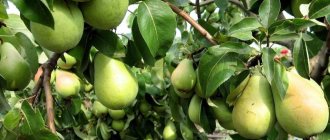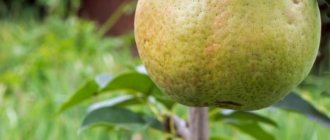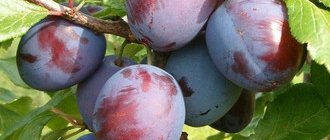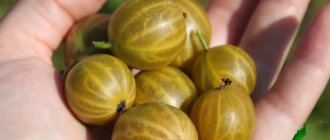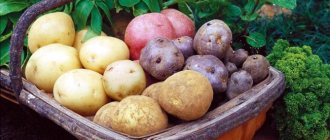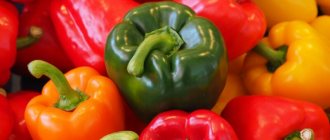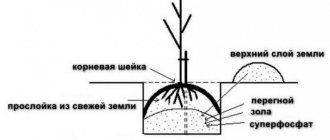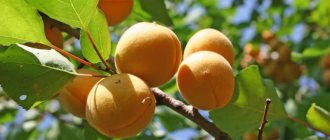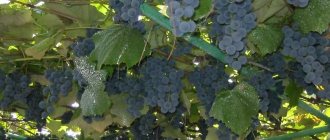Optimal varieties for areas near Moscow
Bicores.
Like all other types of plants, turnip varieties are generally divided into the following types:
- early (the roots of this species usually have a growing season of 50-90 days and are usually used for cooking immediately, as they do not tolerate long-term storage);
- Root crops of medium maturity (the growing season of these varieties is about 120 days, and they are perfectly preserved, and the plants tolerate drought well);
- Later (the roots of these varieties ripen in 120-150 days and are perfectly preserved for a long period of time).
Among the roots of table turnips, the following optimally zoned varieties can be distinguished, taking into account the climatic features of the Moscow region:
1. Early:
- Bicores;
- Red ruby;
- Russian is lonely;
- Nochowski;
- Bolivar;
- Red ball;
- Regala;
- Boltardi;
- Fashionable;
- Libero. .
Detroit
Second half:
- Detroit;
- Egyptian apartment;
- Bordeaux 237;
- Borschtov;
- Redondo;
- Cornell;
- Gentle;
- Bull's blood;
- Valens;
- Raspberry ball.
One-legged.
Three. Late:
- One-legged;
- Citadel;
- Front;
- red cloud
- Bona
- Commander;
- Cylinder;
- Renova.
As you can see, in the Moscow region there are many zonal varieties of beets, and every vegetable grower can choose a root crop based on taste, shape and color. To make it easier to choose the optimal variety, the most popular representatives of vegetables are described below.
Greenhouse beet sissy
There is no particular need to obtain beets in a greenhouse; they ripen safely in open ground. The only advantage is the opportunity to get an early harvest. We sow in February, harvest in May.
The tender leaves of greenhouse beets are good for salads. They are rich in vitamins and other beneficial substances
The leaves are used first. These are the first vitamins in spring salads. We cut them off when they have grown a little. Naturally, not everything, otherwise the beets will not grow. Then root vegetables, also very early, are eaten. Having reached 2-3 cm in diameter, they can be picked after one or two plants so that the rest grow.
There are no special hassles when growing greenhouse crops. She is growing well and gaining weight quickly. It is consumed fresh, because... it is poorly stored. Greenhouse varieties: Boltardi, Pablo, Burpiz Golden. All varieties are early and resistant to bolting. If the spring is very warm or the harvest is not harvested on time, the beets may bloom. Root vegetables will become tough and inedible.
Mid-season beet varieties and hybrids
Mid-season beet varieties and hybrids easily tolerate winter sowing and are not afraid of summer drought. Root crops grow large and are capable of long-term storage.
Bordeaux 237
One of the most popular and studied varieties, which has been known since 1943. The root vegetables are round, weighing 250-480 g. The pulp is dark burgundy, without rings, with a high sugar content. The taste is very high, excellent keeping quality, resistance to disease and drought. A description of beet variety Bordeaux 237 would be incomplete without information about yield. If you follow all the growing rules, you will collect up to 8 kg of root vegetables from 1 sq.m!
Valenta
Single-sprout, high-yielding variety, resistant to cold weather and flowering. Contains a large amount of B vitamins and PP. The roots are round, with dark red flesh, without rings. The pulp is tender and sugary, the leaves are also tasty. The harvested crop does not lose its presentation for a long time.
Two-seeded TSCA
Unlike other varieties, this beet has only 2 sprouts instead of 5-6, so it is easy to thin out. It is also disease resistant. Large round root vegetables grow weighing up to 670 g and have dark red flesh. They store well and have a delicate taste.
Beet varieties from left to right: Bordeaux 237, Valenta, Two-seeded TSHA
Incomparable A463
The name of the variety speaks for itself - this beet has become a favorite of many summer residents. Its root crops are usually flat, sometimes round-flat with dark burgundy skin, weighing 160-380 g. The plants do not suffer from any disease and are resistant to flowering. Once harvested, root vegetables are stored for several months. From 1 square meter you can harvest 3-7 kg of delicious beets. Suitable for any culinary work, does not lose color when cooked.
Pablo F1
A hybrid of foreign selection and a leader in quality and unpretentiousness. Cold-resistant, perfectly tolerates drought, resistant to flowering. Suitable for long-term storage. Root vegetables are round in shape, with thin skin and a small tail. The pulp is red, very tasty, without ring divisions.
Pronto
A variety of foreign selection. The root vegetables are round, weighing 110-150 g, very tasty. Well kept. The variety is resistant to diseases and flowering. Recommended for universal use.
To obtain an earlier harvest, Pronto beet seeds can be sown before winter, in late October - early November.
Beet varieties from left to right: Incomparable A463, Pablo F1, Pronto
Red Cloud F1
Universal hybrid. It grows without problems in unfavorable conditions, especially if there is insufficient moisture. Root crops grow flat-round with burgundy pulp, weighing 160-200 g. There are no rings. The taste is excellent. Beets have a long shelf life and are suitable for consumption raw.
Khavskaya
A single-sprout universal variety that produces 5-6 kg of beets per 1 sq.m. The rounded root crops grow quite large, up to 500 g. This beet does not suffer from flowering, and there are no problems with storage either. There are few rings and the taste is generally very good.
Cold resistant 19
An excellent variety for winter sowing. Resistant to major diseases and can be stored for a long time. The root vegetables are round, weighing 150-220 g, the flesh is dark red, tasty and juicy. If you plant such beets and take care of them correctly, you will reap at least 5 kg of harvest per 1 sq.m.
Beet varieties from left to right: Red Cloud F1, Khavskaya, Cold-resistant 19
How to choose the right variety
Residents of the Moscow region, as well as other regions of Russia, devote a significant part of their plots to beet beds. It grows excellently and without shelter in the Central region; it is not afraid of rain and cold weather like, say, cucumbers, tomatoes or sweet peppers. Beets are also not very susceptible to diseases. So growing this crop in household plots near Moscow is a pleasure.
But sometimes you can hear complaints: our beets don’t grow, we don’t get what we want. They sowed it for early salads, but it sits in the ground and doesn’t grow. They put it in the cellar for the winter - it either rotted or withered. And in borscht it is tasteless, and the color is pale. There are usually two reasons for such problems: either the wrong variety was purchased, or seeds collected from F1 hybrids were sown. So what varieties of beets should be chosen for the Moscow region so that the harvest pleases with its abundance, taste, and lasts until spring?
To get a rich beet harvest, you need to choose the variety responsibly
Unfortunately, it is not always possible to get everything at once. Early varieties, which quickly and quickly produce young root crops already in July, are unsuitable for winter storage, and those that last well until spring usually ripen later and contain less sugars. Therefore, in order to have healthy root crops all year round, it is better to plant both early-ripening and mid-ripening varieties. The State Register of Breeding Achievements contains almost no late beet varieties recommended for cultivation in the Moscow region. Since this is a long-day plant, autumn weather conditions in the middle zone have a rather negative effect on fruit ripening. Therefore, preference is given to varieties that gain the bulk in the warm summer months.
Thus, the following varieties are popular in the Moscow region in terms of ripening time:
- early ones, which ripen 50–80 days after germination and bear fruit for about a month;
- mid-season, which need about 3–3.5 months to form a root crop, and their growing season continues almost until the first frost.
Video: the best varieties of beets
In the last century, a few beet varieties were popular: Bordeaux 237, Gribovskaya flat, Odnorostkovaya, Podzimnyaya, Egyptian flat. Without a doubt, worthy and honored representatives of culture. But if we look at the State Register of Breeding Achievements now, we will see that from the nineties of the last century to the present time, new beet varieties and hybrids appear almost every year. This is not surprising: beets are irreplaceable as protection against adverse environmental factors, and an increasing number of people are realizing this. Therefore, the demand for new and improved varieties of this valuable crop is growing.
I am glad that in our “age of fast food” the popularity of beets and dishes made from them is not falling, but growing
Late-ripening beet varieties
Late-ripening beet varieties are characterized by a long growth period and high resistance to frost and drought. Root crops are perfectly stored until the next harvest and do not lose their marketable quality for a long time. We present three popular varieties that will surprise you with their characteristics.
Single shoot
Easy to grow, versatile variety. Does not require thinning of seedlings. Productivity is record high - up to 10 kg per 1 sq.m. At the same time, the plants are resistant to diseases, and rounded root crops weighing up to 600 g are well stored. As for the taste, it is delicate and sweet, so it is worth growing such beets in the middle zone and the Moscow region.
Salad
A universal variety, ideal for long-term winter storage. Until spring, rounded root vegetables weighing up to 250 g remain juicy and nutritious. The dark red flesh has a good taste. The variety is resistant to diseases and pests. Productivity – up to 4 kg per 1 sq.m.
What varieties are there?
sugar beet
Before deciding on a regionalized variety of this root vegetable, it is important to know that the following varieties exist:
1. Sugar beets are characterized by an elongated, conical shape, white in color. This type of root crop is commonly used for sugar production. This in turn is due to the fact that this type of beet can account for up to 25% of this sweet element.
2. Fodder beet, which has fairly large roots, is commonly used to feed livestock. This type of beet has practically no taste characteristics and is characterized by the presence of a large amount of fiber.
Swiss chard is a plant that has an impressive bottle of spinach and contains a large amount of nutrients in its composition. As a rule, beets of this type are not very common in our country, so their cultivation is not widespread in the Moscow region.
(4) Soroka is considered the most popular variety of this type of root crop, cultivated in almost all regions. The roots of this type of beet can have different shapes and colors, from light pink to dark red burgundy.
Reading information about beet varieties, it is logical to conclude that vegetable growers in the Moscow region usually grow turnip varieties on their farms. Therefore, we would like to draw your attention to the root vegetables of this variety.
Varieties for long-term storage
An equally important characteristic for any vegetable is the ability to store it for a long time. In addition to observing the conditions for proper storage, it is necessary to select those types of this vegetable that, when stored for the winter, retain their quality and taste. Typically, mid-season and late varieties are best stored:
- Bordeaux;
- Renova;
- Gribovskaya;
- Egyptian flat;
- Libero;
- Incomparable;
- Detroit;
- Mulatto.
When choosing beets for open ground, you should take into account its main characteristics and properties: yield, shelf life, sugar content, resistance to plant diseases. It is necessary to take into account the suitability of the selected variety to the climatic conditions of the region where it is going to be grown.
Varieties for different regions of Russia
The best beet varieties for the Moscow region:
- Egyptian flat;
- Red Ball is an early variety that can be harvested after 100 days; sowing in winter is allowed; it tops the list of the sweetest beet varieties;
- mid-season Bordeaux 237, Detroit round, Ataman and Cylinder;
- Borscht, small round root vegetables with dark pulp without rings;
- Renova with dark purple flesh, prefers sandy loam soils.
These same beet varieties are the best for central Russia. This is determined by similar climatic conditions to those in the Moscow region, as well as the low demands of the vegetable.
The best beet varieties for Siberia:
- Siberian Ploskaya will give the earliest harvest, and it is also highly resistant to cold;
- two months after sowing, you can harvest Cold-resistant beets-19;
- Bordeaux and Pablo are also suitable;
- sweet Incomparable beets will also withstand the cold and survive in winter.
What can you read in reviews about the best varieties of beet seeds?
Most often positive responses go towards Bordeaux. It is described as very tasty. Along with it on the list of which beet variety is the sweetest and reddest are Detroit and Red Ball.
Among the reviews about which beets are sweeter, there are those from which it becomes clear that the taste directly depends on the composition of the soil. For example, it has been noticed that clay beets always turn out sweet.
Sources:
https://sadbezproblem.ru/ogorod/luchshij-sort-svekly-dlya-otkrytogo-grunta https://www.ogorod.ru/ru/ogorod/roots/14152/Luchshiye-sorta-svekly-dlya-sredney-polosy -i-Podmoskovia-foto-opisaniya.htm https://www.dom-v-sadu.ru/sladkie-sorta-svekly/
Growing in different climate zones
Although beets are an unpretentious plant, different climatic zones have different conditions and soils. Therefore, suitable varieties need to be selected.
| In outskirts of Moscow | In the middle lane | In Siberia |
| Moderate continental climate, clearly defined seasonality, frequent thaws in winter; The cold month is January, the warm month is July. Winters are long, summers are moderately warm. | Moderate continental with snowy, not very frosty winters and warm, humid summers. Average winter t = -10C, summer = +19C. | Continental climate, sudden temperature changes, heavy rains in summer, early frosts in August. In October there is the first snow. Winters are long, with winds and storms. Winter minimum - 50C. |
| Soil: low-fertility soddy-podzolic soil | Soil: podzolic and sod-podzolic | Soil: permafrost-taiga, podzolic, sod-podzolic; in steppes and forest-steppes - chernozems. |
| Varieties: Egyptian flat, Bordeaux, Cylinder, Borschevaya, Detroit | Varieties: Ataman, Renova, Matryona, Karina, Boyarynya, Bonel, Action F1 | Varieties: Siberian flat, Vodan F1, Pomegranate juice, Bordeaux single-seeded, Kupchikha, Bravo, hybrid varieties |
Beetroot differs not only in its varietal characteristics, but also in its varieties: fodder, sugar, table.
Most varieties are suitable for the Moscow region; they can also be used for winter sowing. For the middle zone - varieties of medium ripening, which have good keeping quality and taste. Medium varieties and hybrids are used in Siberia because... hybrids adapt well to the difficult Siberian climate.
Choosing the right variety is an important and responsible matter. The future harvest will depend on him, and only on him. All the hereditary characteristics that are contained in a small seed will manifest themselves fully as they grow. Taking into account the climatic zone and the characteristics of the variety, you will get full bins of healthy, red-purple root vegetables.
Varieties without light rings
Many root vegetables have white rings on the cut, which somewhat degrade the taste of the beets and add more fiber to them. Therefore, many gardeners believe that the best varieties of beets without light rings are:
- Pablo;
- Detroit;
- Cylinder;
- Cardinal;
- Mulatto;
- A dark horse;
- Oxblood;
- Kestrel has a characteristic feature: when grown, it has faint rings that disappear when the root crop ripens.
Advice from experienced gardeners: help from experienced gardeners
It would seem what questions may arise regarding beet varieties. Sow and reap the harvest. But not everything is so simple...
Question No. 1. I grew very large root vegetables. It would seem that you need to be proud and rejoice. But they are inconvenient to cook, chop, and simply store (I always make a small supply) in the refrigerator.
I grow Detroit, Pablo and Akela. They don't grow big. Aligned in size and rings are not pronounced. Try it!
Question No. 2. I always grow one variety – Cylinder. I like it, but I would like to try something new.
What is the problem? Try other varieties, because there are a great many of them now. Just sow not the entire bed with a new variety, but in rows, for example. What if you don’t like the variety?
Beetroot for the south of Russia
Bordeaux 237
Mid-early, technical ripeness occurs in the period 78-112 days after germination. The root crop has a small rounded head with a somewhat rough surface; its weight is 240-490 g. The color of the pulp is rich dark red. Gives good yields (3.6-6.5 kg). It is considered the best variety among these vegetables for use in winter, as it is rich in vitamins B1 and 2, PP, and can lower blood pressure and prevent hypertension. Adapted to hot climates and has high keeping quality.
Captain
Medium early, with an erect rosette. Its roots are round, the flesh is dark red with an excellent taste. Fruit weight 180-270 g. Gives yields of 3.0-4.3 kg. The highest yield is 6.9 kg. Resistant to flowering.
Harmony
A plant with a semi-erect leaf rosette, produces fruits in the mid-early period. They are round, with a medium-sized head. The weight of the beet root is 260-340 g. The pulp is red, with medium rings, and has a sweet taste. The maximum yields were produced in the Krasnodar Territory - 5.5 kg. (on average - 3.1-3.9 kg).
Early beet varieties
Early, or early ripening, beets are grown for preparing summer dishes, for example, cold soup. It is usually not stored for that long, so most often they try to quickly process root vegetables for culinary purposes. Early vegetables are suitable for consumption even raw. Now let's look at the best early ripening beet varieties.
And I
A very early single-growth variety with round-flat roots. Sweet beets of the Aya variety thrive in Siberia, the Urals and the Far East. But it gives a high yield in the middle zone: about 8 kg per 1 sq.m. The mass of the root vegetable is 180-405 g, the pulp is dark burgundy, juicy and tasty. The first harvest can be harvested from mid-June.
Bravo
A productive, unpretentious variety that stores well and is quite rarely affected by cercospora and beet flea beetle. The weight of one round root vegetable sometimes reaches up to 780 g; the tasty leaves are also suitable for food. The pulp is light burgundy, sugary and dense, without rings. In a word, a wonderful specimen for a summer cottage!
Boltardi
A variety of foreign selection, resistant to frost and disease. The root vegetables are round, the average weight is 210 g. The pulp is dark red and juicy, the rings are poorly defined. When sown under cover, it is suitable for bunch harvesting.
With late sowing, the Boltardi beet harvest can be stored for 3-5 months.
Beet varieties from left to right: Aya, Bravo, Boltardi
Gribovskaya flat A473
A universal variety that will delight you with high yield (3-6 kg per sq.m.), good keeping quality and delicate taste. The root crops of this beet are amazing: they are flat or rounded-flat, weighing up to 420 g. The pulp will not disappoint either - it is red-violet, juicy, practically without rings.
Detroit ruby 3
Another leader in shelf life and disease resistance. It belongs to foreign varieties and is valued for its beautiful roots and compact leaves. Suitable for bunch collection. Beets grow weighing 80-110 g, the flesh is bright red. Sometimes there are small rings.
Root vegetables of this variety have thin skin, so to prevent them from wilting, immediately after harvesting, remove them from the fresh air and indoors.
Egyptian flat
A versatile, unpretentious variety with unusual flat roots. It is not afraid of diseases and drought, and is also resistant to flowering, which reduces the quality of the harvest. If you plant such beets in your dacha, then you are guaranteed 3-6 kg of tasty root vegetables per 1 sq.m.
Beet varieties from left to right: Gribovskaya flat A473, Detroit ruby 3, Egyptian flat
Libero
For an early harvest, it is worth sowing Libero beets. It has round roots with dark red flesh, but almost no rings. What is important is that the beets grow uniform, with a thin root and smooth skin. The taste is excellent. From 1 square meter you can harvest up to 6 kg of juicy root vegetables.
Nochowski
If you want to grow beets with tender flesh and at the same time resistant to long-term storage, pay attention to the foreign selection variety Nochowski. Its round, dark red root vegetables are incredibly tasty. Probably the whole secret is in a small mass - up to 120 g. The root crop is easily pulled out of the soil, because... usually protrudes 3/4 above its surface. The yield is lower than that of other early ripening varieties, but the taste makes up for this drawback.
Podzimnyaya A474
Are you tired of dealing with beet bolting, which prevents your root crops from growing? Then plant Podzimnaya A474 in the garden bed. The variety was bred for winter sowing and is resistant to bolting. You will receive an early spring harvest of round or oval-round root vegetables weighing up to 360 g with juicy dark burgundy pulp.
Beet varieties from left to right: Libero, Nokhovski, Podzimnyaya A474
